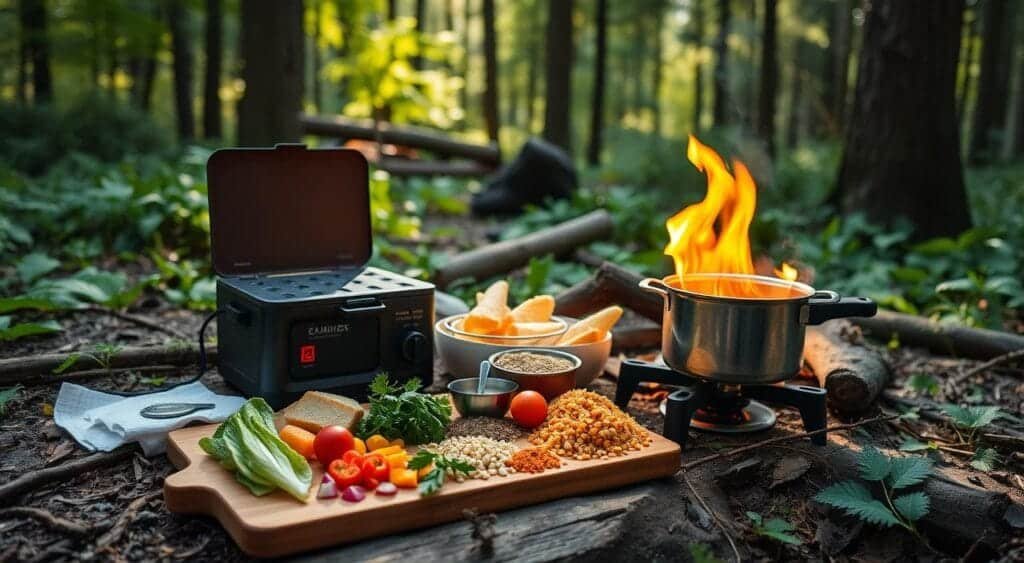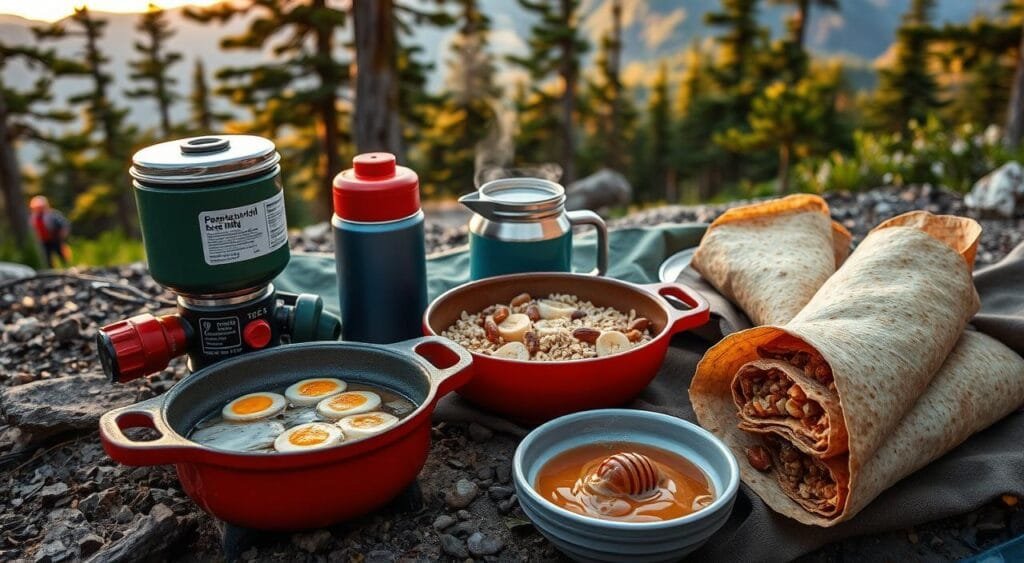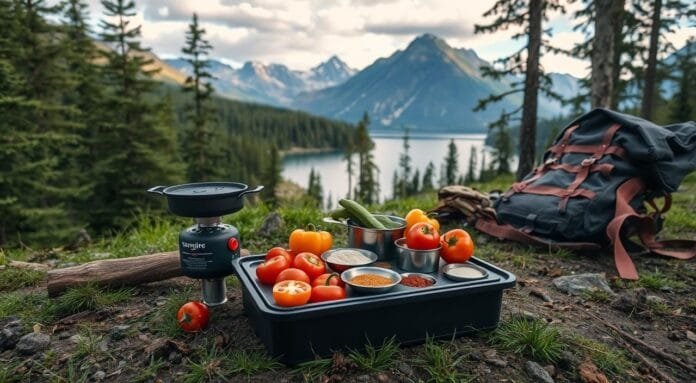As I get ready to hit the trails, the call of nature is strong. Backpacking is my escape from daily life, a chance to connect with nature. But the key to a great trip is the food – it must be tasty, light, and simple to make.
That’s why I’m sharing easy backpacking recipes with you. These meals will give you energy for your adventures. They’re perfect for fueling your hikes.
Making your own trail food can save money and be very rewarding. With dehydrated ingredients and simple items from the store, you can make tasty, healthy meals. These recipes focus on foods that give you energy, like carbs.
Whether you’re a pro or new to backpacking, these recipes will help. They’re designed to be easy, light, and filling. So, get ready to enjoy a culinary journey that will feed your body and soul.
Essential Kitchen Gear for Backpacking Meals
Going on a camping or backpacking trip means you need the right kitchen gear. This ensures you can make tasty and healthy camping cuisine on the go. From the stove that cooks your meals to the utensils that help with backpacking meal prep, each item is important for portable meal planning.
Choosing the Right Stove and Cookware
The Soto Windmaster and JetBoil MiniMo are top picks for stoves. The Soto Windmaster has great flame control, and the JetBoil MiniMo is fuel-efficient and simmers well. For a cheaper option, the AOTU Canister Stove is reliable, and the BRS Ultralight Stove is the lightest canister stove.
For cookware, the MSR Ceramic Pot and Toaks Titanium Pots are great. The MSR Ceramic Pot has a non-stick coating and a pivoting handle. The Toaks Titanium Pots are light and heat up fast.
Storage and Organization Tips
Keeping your backpacking meal prep organized is key. Use resealable bags and containers for ingredients and meals. A dehydrator helps make lightweight, shelf-stable camping cuisine at home. For ingredients, check local stores, specialty suppliers like Harmony House, and online at Nuts.com.
Essential Utensils and Tools
Don’t forget the essential utensils and tools for portable meal planning. The Soto Amicus Cookset and MSR Pocket Rocket Deluxe Cookset are lightweight and complete. For individual items, consider the Sea to Summit Frontier Bowl, Sea to Summit Frontier Long-Handled Spoon, Humangear GoBite Spork, and Opinel Knife. For food security, the BearVault Food Canister and Ursack are good bear-proof options.
With the right camping cuisine gear, you’ll make delicious meals on your next backpacking trip.

Breakfast Backpacking Recipes
Starting your day with a good breakfast is key when hiking or backpacking. There are many tasty and simple breakfasts you can make for the trail. Options range from savory hash browns to sweet granola, making sure you’re energized for your adventure.
Hash browns with scrambled eggs are a favorite for breakfast on the trail. You can use OvaEasy egg crystals for a hot, protein-rich meal. Just mix the crystals with water, then cook them with hash browns for a filling start.
Homemade instant oatmeal is another great choice. Mix rolled oats with dried fruit, nuts, and spices to make packets. Add hot water, and you have a nutritious breakfast. Try adding dried peaches, bananas, or apples for extra taste and nutrition.
- Granola with powdered milk and dried fruit
- Homemade instant oatmeal with dried fruit and nuts
- Hash browns with scrambled eggs using OvaEasy egg crystals
With a bit of planning, you can enjoy tasty breakfasts on the trail. These meals will keep you energized and ready for your adventures.
Best Backpacking Recipes for Lunch and Dinner
It’s important to eat well when you’re out on the trails. This section offers a variety of tasty and healthy meals. You’ll find one-pot wonders, no-cook dishes, and high-protein recipes to fuel your adventures.
One-Pot Wonders
Backpacking meals should be simple. Recipes like revamped ramen and couscous with apricots are easy to make. They also clean up quickly.
Backpacking fried rice is another hit. It uses instant rice and freeze-dried veggies for a tasty, easy meal.
No-Cook Meal Options
Dehydrated meals are great for backpacking. You can make beef & bean chili and Mexican beef & rice at home. Then, rehydrate them on the trail.
Thai dishes like green curry are also easy to make. Use dehydrated curry pastes and coconut milk powder for a delicious meal.
High-Protein Trail Meals
High-protein meals keep you energized. Recipes with lean proteins like mung beans and chicken are perfect. They’re made with lightweight ingredients to keep you fueled without weighing you down.
There’s a wide range of recipes for backpacking. You’ll find one-pot wonders, no-cook meals, and high-protein dishes. Whether you’re vegan, vegetarian, or eat meat, there’s something for everyone.
Trail-Ready Snacks and Energy Boosters
When you start a backpacking trip, having good snacks is key. They help keep your energy up. You can choose from trail mixes, homemade energy bars, and more. These snacks will fuel your adventure and curb your hunger.
Trail Mix Marvels
Trail mix is a must-have for backpackers. It has the right mix of protein, fats, and carbs. Make your own by mixing nuts like almonds and cashews with dried fruits. Add dark chocolate chips or seeds for extra energy.
Homemade Energy Boosters
Making your own energy bars or bites is smart. It lets you pick the ingredients. Mix nuts, seeds, oats, and dried fruits. Use nut butter or honey to hold it together for a tasty snack.
Protein-Packed Picks
Dried meats like jerky are great for protein. Choose lean cuts and minimal additives. Enjoy them with apple slices or veggies for a complete snack.
Freeze-Dried Treasures
Freeze-dried fruits and veggies are light and full of nutrients. They’re perfect for snacks. Try apple slices or strawberries for a vitamin boost.
| Snack | Calories | Weight | Serving Size |
|---|---|---|---|
| Trail Mix | 160-220 | 1-2 oz | 1/4 to 1/2 cup |
| Homemade Energy Bars | 200-300 | 1.5-2 oz | 1 bar |
| Jerky | 70-110 | 1-2 oz | 1-2 ounces |
| Freeze-Dried Fruit | 50-80 | 1-1.5 oz | 1/2 to 1 cup |
Adding these snacks to your backpacking plan will keep you energized. You’ll enjoy your journey more with these tasty treats.

Meal Planning and Food Preparation Tips
Proper meal planning is key for a great backpacking trip. Finding the right mix of lightweight meals and calorie-rich foods is important. This way, you fuel up for your journey without carrying too much weight.
Portion Control and Packaging
Dividing food into individual servings helps manage portions. Use lightweight, resealable bags or containers for your meals and snacks. This makes it easier to keep track of food and share with your group.
Food Safety on the Trail
Keeping food safe is essential when backpacking meal prep. Store perishable items cool and use airtight containers to prevent contamination. Also, remember to pack out all waste, including food scraps and packaging.
Weight and Space Considerations
It’s important to balance nutrition with pack weight and space. Choose lightweight meals like dehydrated or freeze-dried options. Adding a bit of olive oil can boost calories without adding much weight. Plan your camping cuisine carefully to avoid overloading your pack.
By following these backpacking meal prep tips, you can enjoy a balanced and efficient dining experience on the trail. Good planning lets you focus on the adventure and make the most of your time outdoors.
Conclusion
Backpacking meals can be both tasty and healthy with the right planning. Trying out different backpacking recipes and ingredients helps find the best mix of taste, nutrition, and ease. Making your own meals saves money and lets you tailor them to your liking, unlike store-bought hiking food ideas.
Learning to make lightweight meals can make your outdoor trips better and keep you well-fed. The recipes and tips in this article show that backpacking food can be exciting. With some creativity and a focus on quality, your wilderness meals can be a highlight of your trip.
Whether you’re going on a long trip or a short day hike, using these backpacking recipes can make your meals more enjoyable. Don’t be afraid to try new ingredients and cooking ways. Let your taste buds lead you on your next backpacking adventure.
FAQ – Backpacking Meal Planning
What are the calorie requirements for backpacking?
Aim for 25-30 calories per pound of body weight per day when planning backpacking meals.
Why is it cost-effective to prepare your own backpacking meals?
Commercial backpacking food can be pricey. Making your own meals with dehydrated ingredients and grocery items is cheaper.
What essential kitchen gear is needed for backpacking meals?
You’ll need a stove, a pot of 600-700mL per person, and a spoon for easy cleaning. A pot cozy saves fuel and keeps food warm.
What are some popular breakfast options for backpacking?
Good breakfasts include hash browns with scrambled eggs, granola with powdered milk and dried fruit, and instant oatmeal. Pre-pack granola with powdered milk and dried fruit in ziplock bags for a quick breakfast.
What are some easy one-pot meal options for backpacking?
Simple meals like revamped ramen, couscous with apricots and spices, and loaded mac & cheese are favorites. Backpacking fried rice is also a hit.
What are some protein-rich snack options for the trail?
Dried meats like jerky or biltong are great snacks. Trail mix and homemade energy bars or balls are also good choices.
How can I properly plan and prepare backpacking meals?
Plan meals by portioning food into individual servings. Use lightweight, resealable packaging. Dehydrating meals reduces weight and space. Consider food’s caloric density and add olive oil for extra calories. Always follow food safety and leave-no-trace principles.














